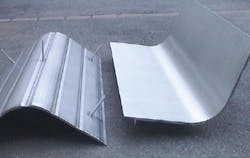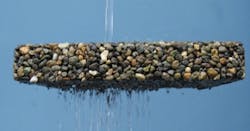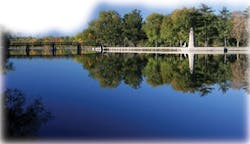By Mark O. Liner
Scientists write in paragraphs, engineers write in bullets, and operators write in logs. And contractors, well, I have yet to see one write anything down. So, taking a scientific concept and getting it to reliable performance can be a real drama. Over the past decade, the science of natural treatment systems has been pushed to the test and many “boutique” treatment systems have been put through the process of moving the science through engineering to real world performance. This is particularly true with industrial wastewater treatment.
Pilot unit configured to evaluate aerated wetlands.
A well thought out methodical process of developing a natural treatment system design to help manage risk should include the following components: basis of design, process selection, bench scale testing, demonstration/full scale tests, engineering for construction, and operations to maximize performance.
Basis of Design
The process begins with the basis of design. The cost of a project is directly related to this first step and it pays to get good data at the beginning. One of the pioneers of wastewater treatment, Wesley Eckenfelder, wrote that you only need to know the concentration in, the concentration out, and the flow to design a system. That still is true, even though flows can be seasonal or intermittent, concentrations unknown, and treatment requirements assumed.
Process Selection
Process selection is next and this is where a consultant makes their mark – the balance of experience and knowledge streamlines the selection of treatment components. In natural systems, the components are normally variations on lagoons and wetlands: lagoons used for roughing and wetlands used for polishing. At the current stage of technology development, these components are being highly engineered as unit processes with particular treatment objectives. For example, in the case of treatment of deicing fluid from airport operations, aeration systems are sized to meet the organic loadings associated with deicing fluid. With landfill leachate, where nitrogen removal is often a concern, advanced biological methods are being employed to achieve ammonia removal.
Pilot unit used to evaluate treatment of mine tailings water by a wetland system.
Bench Scale and Demonstration Testing
Bench scale testing, modeling, and process sizing are the next step in the system design process. During this phase, the science is tested against the basis of design. This is an area in which natural treatment systems enjoy a great deal of study, particularly with respect to high-strength wastewater treatment. Many universities are actively involved in assessing the ability of wetland systems and this growing core of knowledge has provided a strong foundation for the use of natural systems in these applications.
Demonstration tests are full scale modules of the system to examine real world performance with actual wastewater. This phase provides valuable insight with respect to construction, hydraulics, and flexibility in handling influent fluctuations.
Engineering and Operation
The last two phases of the process are similar to other wastewater projects: engineering for construction and operating the system to optimize performance. It is the initial phases of the design process that provide certainty related to the level of risk and the expected performance from the system.
Basis of Design - Buffalo Airport - Deicing Fluid
Development of a basis of design for treatment of airport deicing fluid is a notably difficult assignment. Flows are highly variable and associated with storms and intermittent freeze-thaw events. Concentrations of glycols, formates, and other deicing compounds are variable as well and their levels in the waste stream directly relate to the quantity of chemical used to deice the planes and runways. Extremes range from low flow and high concentration during a February hard freeze to high flow and low concentrations during a spring storm.
Full scale demonstration of wetland aeration for treatment of deicing fluid from Heathrow Airport in London
With the extremes in flow and concentration, a scientific approach was used to establish a design basis for the treatment system now operating at Buffalo Niagara International Airport in Buffalo, NY. Influent flow and Biological Oxygen Demand (BOD) data was compiled and analyzed on a mass basis to determine the spectrum of system loadings over a typical deicing season. Using this approach a treatment system sizing requirement of 10,000 pounds of BOD/day was established.
Process Selection – Pacific Northwest – Landfill Leachate
Engineering of wetlands has tended to follow developments in the domestic wastewater treatment world. From addition of aeration to improve bacterial oxidation of hydrocarbons to the use of tertiary submerged attached growth reactors for ammonia removal, the process of designing wetlands is proving similar to that of designing mechanical treatment systems. The units are wetlands and lagoons instead of membrane bioreactors and oxidation ovals.
A case in point is the investigation of using an anammox-like process (Anaerobic Ammonium Oxidation ) for the conversion of ammonia and nitrate to nitrogen gas for landfill leachate. This advanced, biological process is currently used for high strength ammonia streams in sewage plants. The use of anammox-like processes is relatively new to the wastewater world and has garnered much attention. But there is a “however”, and that is that scientific understanding has been slow to make inroads to the engineering world; let alone the world of natural treatment systems.
Remote mines, like this one in South America, use onsite pilot test to size wetland treatment systems
To assist in the process selection for a landfill leachate design, a large-scale pilot study was undertaken. The pilot system was configured to investigate how continuous and intermittent aeration would affect performance of a wetland-based treatment system. The results of the work quantified the value of employing different modes of aeration: intermittent aeration achieved 400% more nitrogen removal when compared to the continuously aerated system. The clear difference in treatment performance has been fundamental in not only selecting a mode of aeration for the system but also for a simple proof of concept for a biological process not widely (or purposely) employed with natural treatment systems.
Bench Scale Testing – South America – Goldmine Tailings
A remote goldmine in South America was in need of a low O&M system to treat ammonia from the cyanide-laden water in its tailings pond. Over 16,000 m3/day of water required treatment prior to discharge to the adjacent river. A treatability test was conducted to determine the rates of ammonia removal and to support the sizing of the wetland system.
The testing was done in three phases. In the initial phase, artificial leachate was formulated and tested in a wetland reactor located in a laboratory. During the second phase of testing, actual water from the site was shipped to the laboratory for testing in the same reactor. During the final phase of testing, a reactor was constructed and tested on site. Results from the testing demonstrated successful removal of ammonia with no inhibition of nitrification. Moreover, the testing provided a basis for sizing of the wetland cells.
Demonstration Testing – Heathrow, Airport – Deicing Fluid
Spent deicing fluid from Heathrow Airport in London, England, is collected and sent to nearby Mayfield Farm for treatment. The treatment system is composed of aerated lagoons and constructed wetlands. Aeration of the existing subsurface wetland beds was undertaken in 2009 so as to demonstrate the effect on treatment. Three of the existing beds were tested in parallel. The first bed was unmodified, the second bed was re-piped to a vertical flow configuration, and the third bed was reconfigured like bed number two and also aerated.
Results from the full-scale demonstration test clearly illustrate the benefits of aeration. Removals of chemical oxygen demand (COD) are consistent and directly associated with the level of aeration in the beds. Second to the proof of performance, the full scale modifications also provided valuable information with respect to constructability and the level of effort required to modify the existing asset to improve performance.
Engineering – BP Casper – Groundwater Remediation
Once the front work is complete, the engineering team can confidently employ the results to develop a design based on science that achieves the required treatment goals. The basis of design is used with bench scale testing to size the unit processes. Though for some projects, like the award-winning groundwater remediation project conducted for BP in Casper, WY, the engineering takes on an additional level of effort.
The system is designed for treatment of up to 11,400 m3/d of gasoline-contaminated groundwater. This process includes cascade aeration for iron oxidation and air stripping, a soil-matrix biofilter for gas-phase benzene removal, surface flow wetlands for removal of ferric hydroxide precipitates, stormwater retention wetlands, and subsurface wetlands for BTEX removal. It is a sophisticated treatment system supported by bench-scale testing and extensive baseline monitoring data that is anticipated to operate over 100 years.
A more difficult aspect to the project, however, was the requirement to fit the treatment system into the landscape of the site, which includes an office park, river front trails, and a whitewater kayaking course. Designing the process around engineered wetlands allowed the process components to be incorporated into the site; aesthetically blending the hard core science of chlorinated hydrocarbon treatment into the rolling landscape of a golf course.
Conclusion
Wastewater treatment can be thought of as an assembly line that runs backwards. Instead of assembling, we make and operate systems to disassemble the wastewater to get it back to its original clean state. And it is easy enough to do if you can follow someone else who has done it before. But often the situation is unique and a methodical process is needed to dream up, engineer, and get a system on line. This process of going from science through engineering to long-term operations is particularly evident in work with natural treatment. Experience with mines, airports, groundwater remediation, and landfills have proven how such a deliberate approach delivers successful projects.
About the Author: Mark O. Liner, P.E., is a senior engineer with Naturally Wallace Consulting. Over his 20 year career, he has worked as a regulator at EPA headquarters, as a process and equipment supplier, as a design-build project manager, and as a consultant engineer for industrial clients. He has designed over 500 new and retrofit treatment systems across the world. He specializes in the design of onsite treatment systems for industrial facilities with an emphasis on airport deicing, mines, landfill leachate, and remediation.





